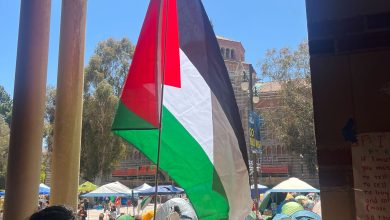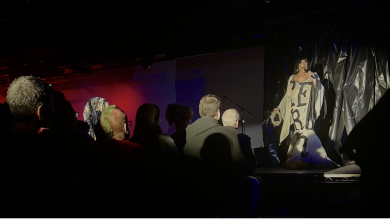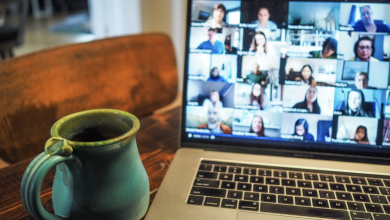Body Dysmorphia and Inherited Trauma in the Stolen Generation

Design by Monica Juarez
On Monday, Nov. 26, the UCLA American Indian Studies Center hosted a presentation entitled “Living as Indigenous Inside the Dysmorphic Body” led by Dr. Stephanie Gilbert. Dr. Gilbert, a Fulbright Scholar on a PostDoctoral Fulbright Scholarship at UCLA, presented some of her current research on the body, identity, and inheritable trauma at the Charles E. Young Research Library. Focusing primarily on the “Stolen Generation” from Australia, she argued the forced removals experienced by the Stolen Generation of Australia and other indigenous peoples in the past resulted in their own form of body dysmorphia, and that such trauma could be passed down as inherited memories in subsequent generations through epigenetics.
Leading up to her presentation, Gilbert said she was interested in looking at the outcomes childhood removal had on indigenous people as they grew into adulthood. Looking back at her own life dealing with her body as an indigenous woman, she wondered aloud: “What if you looked down and saw brown skin but felt disgust and confusion?” Part of the confusion, she explained, stems from people saying she was white, but the actions of institutions and other people confirming that she was not actually seen as white. Gilbert was interested in exploring these multiple narratives about aboriginal bodies.
The screen projected two circles labelled “Inheritable Memory” and “Body Dysmorphia,” connected by a single line labelled “Space.” Gilbert presented the conceptual building blocks of her Fulbright project including the key words: body, removed/boarded children, indigeneity, epigenome.
Introducing her concept of body dysmorphia, Dr. Gilbert presented psychiatry’s definition of body dysmorphic disorder, “characterized by persistent and intrusive preoccupations with an imagined or slight defect in one’s appearance,” and of gender dysphoria, described as a similar bodily discomfort except with one’s gender. Instead, she was interested in how these scientific and Euro-American-based theoretical concepts specifically connect to indigenous people’s experiences and trauma.
According to Gilbert, body dysmorphia among the Stolen Generation of Australia developed as a result of legislation calling for the removal of indigenous children from their families from the 19th century to the mid-20th century. Through justifications such as “neglect” as cause to forcibly take children from their indigenous mothers and families, these forms of legislation promoted the erasure of aboriginal and mixed-race children from society.
After removal, the abducted children were then systematically denied their identity in numerous way, such as the government changing the children’s names and dates of birth, or being assigned an identifying number instead of being called by a name.
Another form of control by the colonial government was the consistent effort to have indigenous children view themselves as white instead of aboriginal. As Australia became an independent nation in 1901, the country promoted the idea that the whiteness of skin was a marker for a real Australian. Indigenous children were told they were white in order to assimilate into white Australian society, affecting their mental perception of themselves and contributing to their body dysmorphia regarding their indigenous identity.
Gilbert remarked on her own experience trying to live as white while never accepting herself as anything other. This lack of a concrete identity left Gilbert filled with humiliation, anger, and hatred, preventing acceptance of her indigenous identity. Like many others, Gilbert occupied a gray area in terms of identity. She wasn’t accepted as white, but couldn’t accept herself as indigenous.
Gilbert’s research into inherited memory was inspired by a 1994 conference she attended that broached the concept of trauma. She was curious whether trauma suffered by the removed children could be passed down biologically. Gilbert foraged into the world of DNA to see if it was possible to pass down trauma from parent to child, from generation to generation, in the same way genetics are passed down. As some argue that DNA is what truly defines you, Gilbert was curious to see where in DNA lies indigeneity and the memories of trauma?
Focusing on epigenetics, the term used to describe heritable traits that do not involve changes in the DNA sequences, Gilbert wondered if indigeneity or inherited memories could be applied to epigenetic tags, or certain cells passed down from the mother. In addition, it’s been shown that trauma can affect the brain, leaving the possibility of trauma being passed down. However, proving that epigenetic tags include inheritance of trauma is a challenge that requires further research.
Gilbert also explored the possibility of body dysmorphia among the indigenous populations in the United States and Canada. She argued that similar precursor conditions for body dysmorphia exist, as children were removed from their homes and sent to federal boarding schools. Their identities were removed through the changing of names and assimilation of language, among other things.
Towards the end of the presentation, Gilbert acknowledged that in recent years, the countries with history of indigenous child removal from their families have issued official apologies. However, she considered them lackluster in providing sufficient healing or solutions for the irreparable damage caused to generations of indigenous peoples.
During the Q&A section after her presentation, an attendee asked what advice Dr. Gilbert would give to young indigenous people such as himself wanting to learn more about their people’s history of trauma, and how to go through life knowing what young indigenous people of the past had gone through. Dr. Gilbert advised him to continuously read and learn about the different experiences and journeys of people who have come before them in history, both to understand and to work out where they are on their own individual journey. Towards the end of her answer, she placed a comforting hand on the shoulder of a now emotional attendee, as the weight of the pain and suffering of a past generation reverberated throughout the room.
The simple yet powerful moment showed how, despite the time passed since the forced removals of indigenous children and the official apologies issued since, the outrage at the infliction of pain on children over something as simple as the color of their skin is still very much felt to this day.




